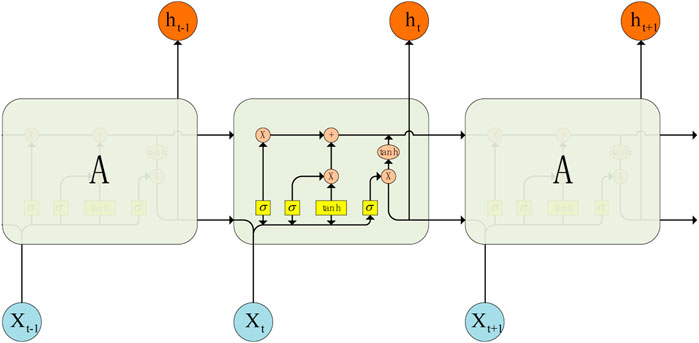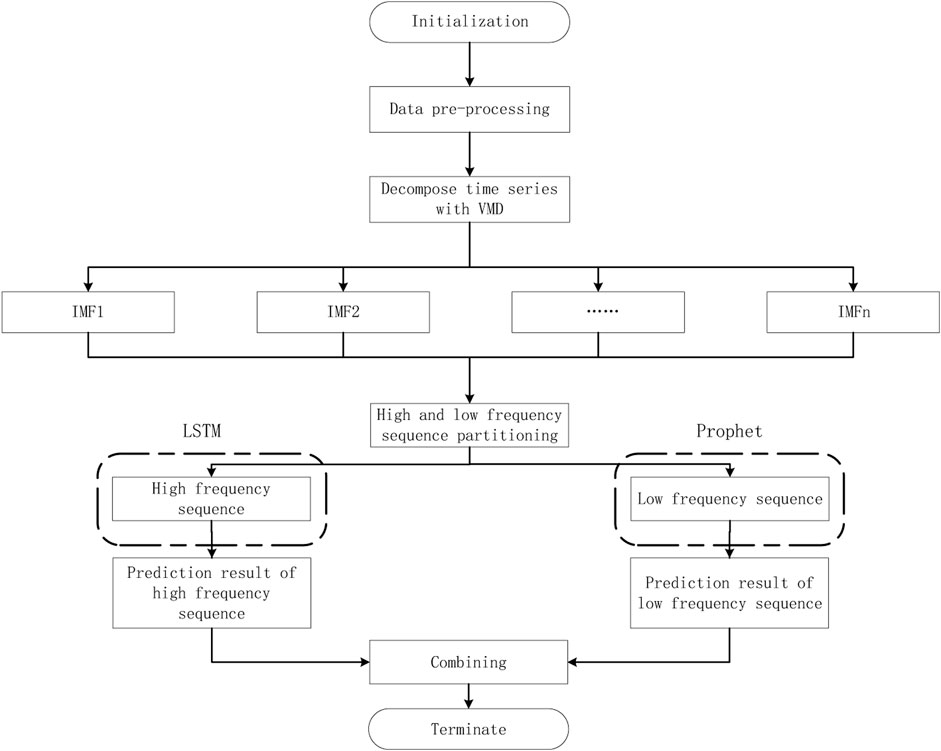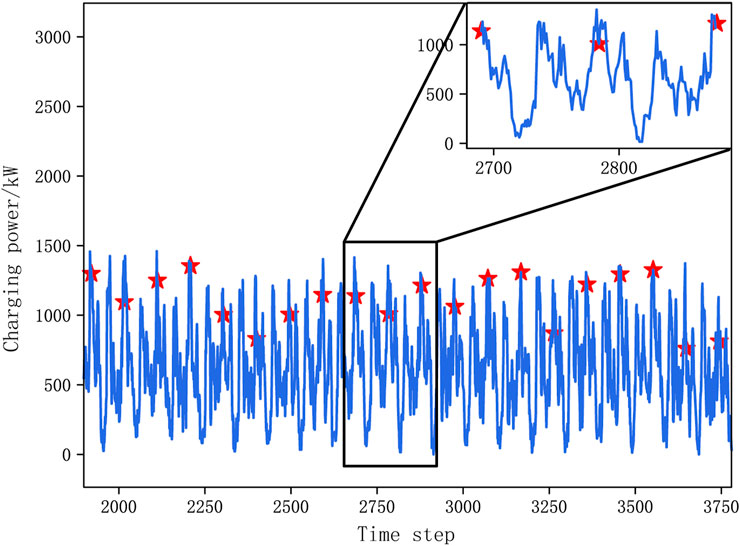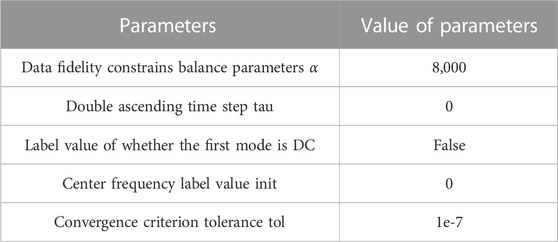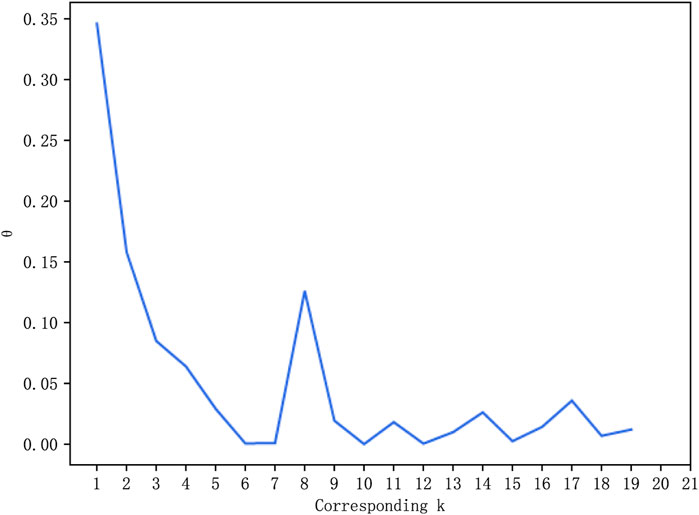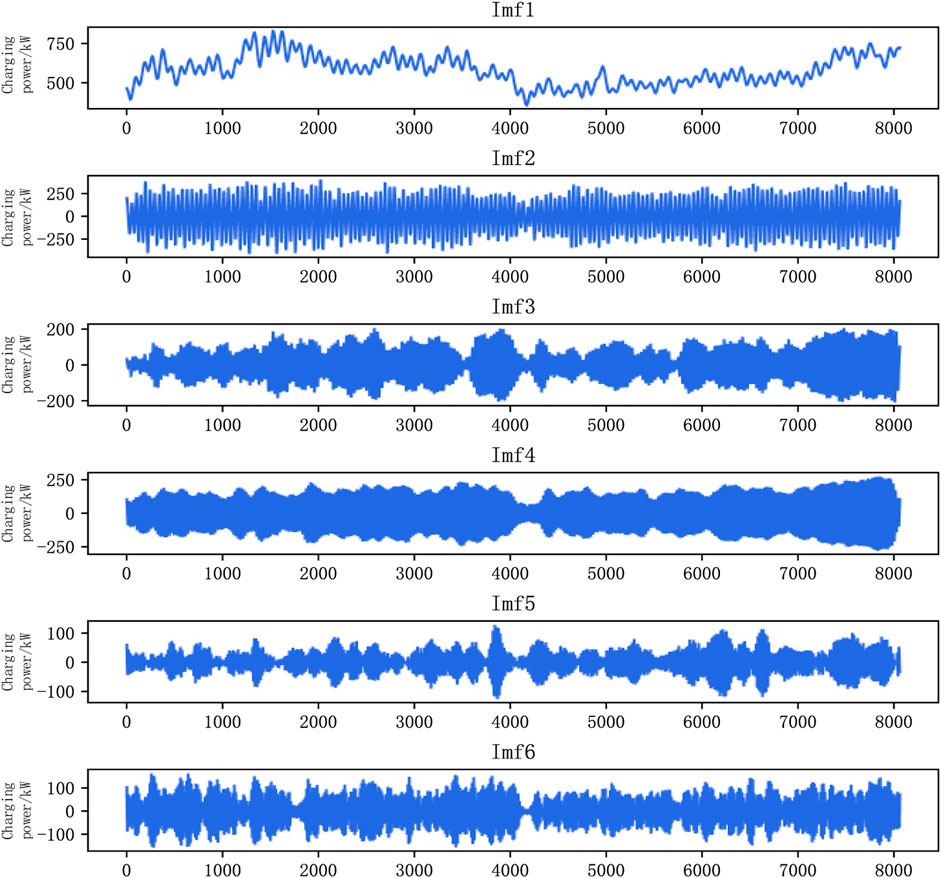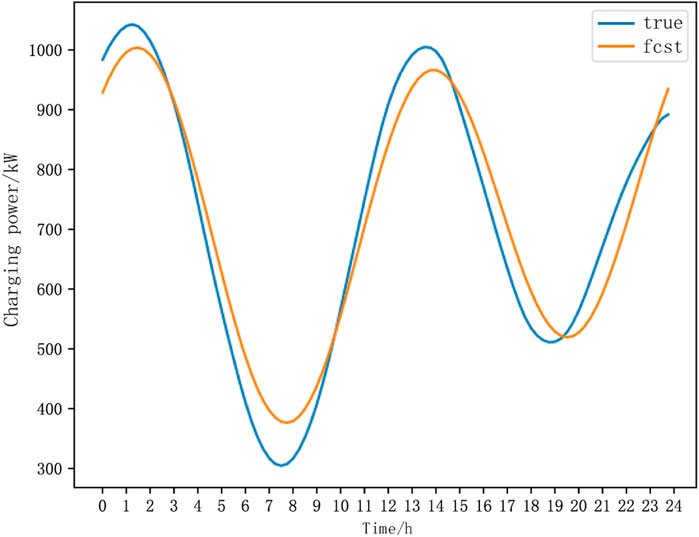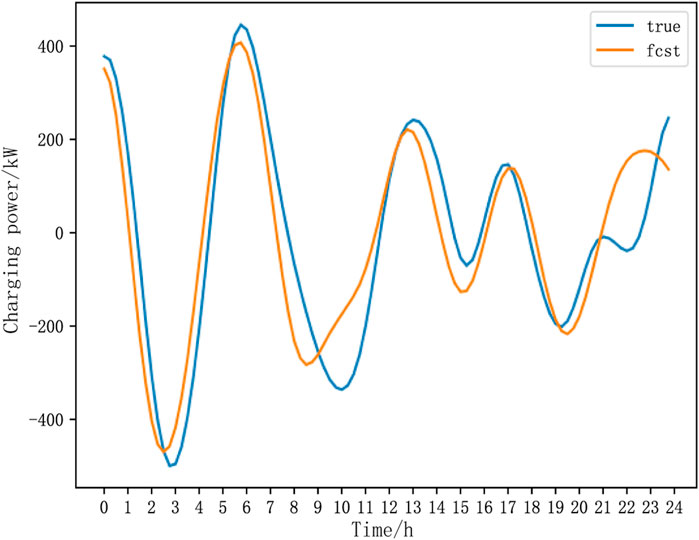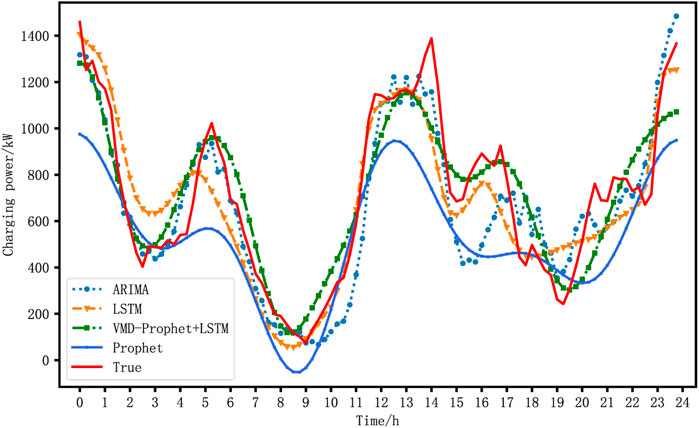- 1State Grid Fujian Economic Research Institute, Fuzhou, China
- 2State Grid Fujian Electric Power, Fuzhou, China
- 3College of Electrical Engineering and Automation, Fuzhou University, Fuzhou, China
With the large-scale development of electric vehicles, the accuracy of electric vehicle charging load prediction is increasingly important for electric power system. Accurate EV charging load prediction is essential for the efficiency of electric system planning and economic operation of electric system. This paper proposes an electric vehicle charging load predicting method based on variational mode decomposition and Prophet-LSTM. Firstly, the variational mode decomposition algorithm is used to decompose the charging load into several intrinsic mode functions in order to explore the characteristics of EV charging load data. Secondly, in order to make full use of the advantages of various forecasting methods, the intrinsic mode functions are classified into low and high frequency sequences based on their over-zero rates. The high and low frequency sequences are reconstructed to obtain two frequency sequences. Then the LSTM neural network and Prophet model are used to predict the high and low frequency sequences, respectively. Finally, the prediction results obtained from the prediction of high frequency and low frequency sequences are combined to obtain the final prediction result. The assessment of the prediction results shows that the prediction accuracy of the prediction method proposed in this paper is improved compared to the traditional prediction methods, and the average absolute error is lower than that of ARIMA, LSTM and Prophet respectively by 7.57%, 8.73%, and 46.02%. The results show that the prediction method proposed in this paper has higher prediction accuracy than the traditional methods, and is effective in predicting EV charging load.
1 Introduction
At present, the problems of environmental pollution and energy resource crisis are becoming more and more serious. Oil-fueled automobiles are causing serious environmental pollution and high energy consumption. Electric vehicles (EVs) offer cleaner energy and environmental advantages over petrol vehicles, effectively alleviating problems such as energy resource shortages and severe air pollution (Wu and Zhang, 2017). Consequently, EVs have been widely promoted globally, and in China, the government has vigorously advanced the construction of public and private EV charging stations (Gao and Zhang, 2011). However, a significant number of EVs connecting to the power grid can also have an impact on the power grid. According to (Das et al., 2020), EV charging equipment may cause harmonic pollution to the grid, and the clustering effect of EV charging will have a significant impact on distribution networks. Chen and Huang (2019) demonstrates that the disordered charging of huge numbers of EVs will have impact on the safety and reliability of electric power system. At the same time, since the effective prediction of EV charging load is a prerequisite for the analysis of the impact of EV charging on the power grid, it is of great significance to conduct accurate EV charging load prediction (Yin et al., 2023).
Significant progress has been made in research on EV charging load predicting all over the world. EV charging load predicting can be divided into two categories: statistical model-based predicting methods and deep learning-based predicting methods (Yin et al., 2023). The methods based on statistical models are relatively simple, computationally efficient, and have faster prediction speeds (Luo et al., 2019). Selvi and Mishra (2021) utilizes a functional linear regression model to predict the day-ahead power load. Bahrami et al. (2014) employs a short-term power load prediction model that combines wavelet transform with grey model, and the high frequency component of the load is effectively eliminated, and the prediction accuracy is improved. de Oliveria and Oliveria (2018) forecasts medium-term electricity load using an autoregressive integrated moving average model (ARIMA) with a seasonal trend decomposition model combining weighted regression. Luzia et al. (2023) forecasts Brazilian electricity demand with ARIMA combined with Wavelet Transform and Fourier Transform. Wang (2022) utilities ARIMA combined with BP neural network to predict per capita coal consumption of China. The above-mentioned models can achieve rapid predictions for simple time series with high accuracy. However, these models have poor robustness and perform less effectively in predicting power loads with abrupt variations.
Deep learning-based prediction methods can overcome the limitations of statistical model-based methods in predicting complex sequences. Nikolaev et al. (2019) predicts wind power generation using recurrent neural network (RNN). However, RNN may encounter issues such as vanishing or exploding gradients during the training process, which can affect the prediction accuracy. Bouktif et al. (2018) predicts electricity consumption in a particular city with Long Short-Term Memory (LSTM) neural networks. They further optimized the time lag features of the LSTM network using genetic algorithms (GAs). LSTM networks address the problems of vanishing and exploding gradients that occur in RNNs. Liu et al. (2019) utilizes support vector machines (SVMs) to predict electricity load and employs empirical mode decomposition (EMD) for denoising the power load data. Wang et al. (2021) proposes a short-term electricity load predicting model based on a locally random sensitivity deep autoencoder (D-LiSSA). The model utilizes a nonlinear fully connected feedforward neural network as the regression layer and utilizes the learned hidden representations from D-LiSSA to enhance the generalization ability of the model.
While deep learning-based prediction methods are effective in handling nonlinear problems, their performance is influenced by the quality of input data. In real-world scenarios, EV charging loads are affected by many factors like electricity prices, temperature, date and so on. Forecasting using only a single forecasting method can have an impact on forecasting effectiveness (Luo et al., 2019). Therefore, it is necessary to preprocess the data using appropriate methods and employ ensemble prediction models for forecasting the preprocessed data. To address this, Lu et al. (2019) utilizes convolutional neural networks (CNNs) to extract feature vectors from a massive amount of electricity load data and uses them as inputs to an LSTM neural network to obtain load predictions. However, this approach only utilizes superficial features of the data and does not perform deep analysis. Time series data can be divided into components with different characteristics using certain methods. The effect of disjoint features on prediction can be avoided by predicting the partitioned components. Therefore, Yang et al. (2021) decomposes the photovoltaic power output into components with different frequencies with Variational Mode Decomposition (VMD) and uses LSTM to predict them, then, integrates predicting results to get the final predicting result. In a similar manner, Wang et al. (2020) uses a deep echo state network (DESN) to establish prediction models for each component obtained through VMD, and the predicting results are integrated to get the result. However, these methods do not consider the characteristics of each component during the predicting process and solely used a single model to predict each component. In order to get better predicting result, researchers have divided the components obtained through VMD decomposition of electricity load data into high-frequency and low-frequency sequences (Cai et al., 2022; Yu et al., 2022). Cai et al. (2022) employes gate recurrent units (GRUs) and temporal convolutional networks (TCNs) to predict the high-frequency and low-frequency sequences, respectively. Then reconstructs the final predicting result. Similarly, Yu et al. (2022) utilizes GRUs and ARIMA models to predict the high-frequency and low-frequency sequences separately and combines the predicting results to obtain the result. These ensemble prediction methods consider the characteristics of each component, leveraging the advantages of different prediction models for high and low frequency sequences. Compared to utilizing a single prediction model, these approaches enhance the prediction accuracy. However, the ARIMA algorithm requires more background knowledge and parameter tuning, making it more complex. Moreover, when dealing with missing data, manual imputation and handling are necessary for the ARIMA algorithm. On the other hand, the Prophet algorithm overcomes these drawbacks of the ARIMA algorithm and is better suited for medium-scale time series data forecasting.
Based on the above analysis, an EV charging load predicting method based on VMD and Prophet-LSTM is proposed in this paper to improve the prediction accuracy of EV charging loads. Firstly, for mining the characteristics of EV charging load data, the load data is decomposed into several intrinsic mode functions (IMFs) using VMD algorithm. Secondly, to fully leverage the superiorities of each prediction model, the IMFs are divided into high and low frequency sequences using zero-crossing rates, and each sequence is reconstructed individually. Then the high and low frequency sequences are predicted using LSTM neural networks and the Prophet model, respectively. Finally, the predicting results for high and low frequency sequences are combined to get the final predicting result. Evaluation of the predicting results shows that the predicting method proposed in this paper achieves improved prediction accuracy compared to traditional methods. The average absolute error of the proposed method is lower than ARIMA, LSTM, and Prophet prediction models by 7.57%, 8.73%, and 46.02%, respectively.
2 Decomposition of EV charging load
2.1 VMD
The VMD method is a technique for estimating individual signal components by solving a variational optimization problem in frequency domain (Dragomiretskiy and Zosso, 2014). This method can decompose complex unstable sequences into IMFs with finite bandwidths, denoted as
The principle of the variational problem is that the decomposed sequence is a finite bandwidth modal component with a central frequency. The original sequence is decomposed into k sub-sequences, and the sum of all sub-sequences is guaranteed to be the original sequence, while the sum of the estimated bandwidths of the sub-sequences is minimum. The constrained variational problem is shown as follows:
where k represents the number of desired mode components to be decomposed;
where
The constrained variational problem can be transformed into an unconstrained variational problem by introducing the Lagrange multiplier operator and the augmented Lagrange expression is as:
where
where γ represents the noise margin, which meets the fidelity requirement of decomposition of signal;
2.2 Division of high and low frequency sequences
Sequences with high frequency that possess poor stationarity and complexity are predicted by LSTM neural network. This paper uses the Prophet model to predict sequences with low frequency that are stable and periodic. Therefore, it is necessary to divide the intrinsic mode functions obtained by VMD processing into sequences with high and low frequencies.
This paper primarily utilizes the over zero rate of a sequence to divide the high and low frequency sequences. The over zero rate of a sequence is defined by the following equation:
where
3 Predicting method of EV charging load based on Prophet-LSTM
3.1 Prophet model
The Prophet model is a time series forecasting model developed by the Facebook team (Taylor and Letham, 2018). This model fits the time series by considering trend components, seasonal components, holiday effects, periodic components, and error terms. The prediction results are obtained by combining these fitted components. The Prophet model can be represented by the following equation:
where
The trend term can be expressed as:
where
The holiday effect can be represented by the following equation:
where
The Prophet model is a model-based forecasting method. Currently, another popular model-based forecasting method is the ARIMA model. The Prophet model incorporates the advantages of the ARIMA model while avoiding its disadvantages such as limited robustness and the inability to consider external factors that influence time series changes. Therefore, this paper chooses the Prophet model to predict stationary low-frequency sequences.
3.2 LSTM neural network
LSTM neural networks are a variant of recurrent neural networks (RNNs) that were primarily developed to address the issue of vanishing and exploding gradients that can occur in RNNs during long sequence predictions (Li et al., 2018). Compared to traditional RNNs, LSTM neural networks have improved performance in long sequence predictions.
LSTM networks extend the basic structure of RNNs by introducing additional components such as input gates, forget gates, output gates, and a concept known as the cell state. These additions allow LSTMs to selectively retain and discard information over time, enabling them to capture long-term dependencies more effectively. The architecture of an LSTM network is illustrated in Figure 1.
LSTM neural network has a more complex structure compared to traditional RNNs, as shown in Figure 1. LSTM introduces the concept of a cell state and utilizes input, output and forget gates to control and retain information. The calculation for LSTM at time step t is as follows:
where
The forget gate combines the foregoing hidden state with the present input, and utilities the sigmoid function to determine which information to discard. The sigmoid function outputs values between 0 and 1. It discards part of the information when its value is approaching to 0 and keeps the information when its value is nearly 1.
The input gate and the tanh function determine which new information to incorporate from the foregoing hidden state and the present input, resulting in a candidate value
The LSTM neural network constructed in this study consists of a 96-dimensional input layer, a 1-dimensional output layer, two LSTM layers, and four fully connected layers. The number of neurons in these layers is 128, 64, 32, and 16, respectively. The activation function chosen for the LSTM layers is the hyperbolic tangent (tanh) function. The Adam optimization algorithm is used to minimize the error during training. This LSTM neural network is utilized for predicting high-frequency sequences with significant variations. Through multiple iterations and training, an effective LSTM prediction model is obtained, which is capable of capturing complex temporal dependencies and making accurate predictions.
3.3 Prophet-LSTM combination model
Since the EV charging load time series is highly influenced by real-world factors, the time series exhibits pronounced variations. Predicting such time series using a single forecasting method without considering the relevant factors often results in poor prediction performance and large errors. Therefore, it is necessary to utilize a combination forecasting model. In this study, a Prophet-LSTM prediction model is established. The proposed model takes the advantages and disadvantages of both the Prophet and LSTM model into account. The Prophet model is employed to predict low-frequency sequences with relatively smooth variations, while the LSTM neural network is used to predict sequences with high frequency with more pronounced variations. By dividing the original complex time series prediction problem into two relatively simpler time series prediction problems, better prediction results can be achieved. The overall prediction process is illustrated in Figure 2.
3.4 Error evaluation index selection
To assess the prediction performance of the Prophet-LSTM model, this study uses the mean absolute error (MAE) as well as the goodness-of-fit to evaluate(R-squared) the prediction results. The calculation methods for MAE and R-squared are as follows:
where
4 Results
The hardware environment for the experiments includes an Intel i5 8300H 2.3 GHz CPU and an NVIDIA GTX 1050Ti graphics card, with 16 GB of memory. The model was implemented using Python 3.9 as the programming language, utilizing software architectures such as TensorFlow, Keras, and the Prophet algorithm framework for power load forecasting.
4.1 Data processing
This study utilizes EV charging data from a charging station in Fujian Province, China, spanning from January to April 2022. The sample time of the data is 15 min. The EV charging power curve is depicted in Figure 3.
Each red “☆” in Figure 3 represents 24:00 of the previous day and 0:00 of the next day. The power data between two consecutive “☆” markers is complete data set for each day. From Figure 3, it can be observed that the raw data has a certain periodicity. Given the 15-min data granularity, this study defines 96 time steps as 1 week. However, the daily variation of the charging load is quite volatile, and the sequence is not sufficiently stationary. Using a single forecasting method for prediction would result in poor performance. Therefore, this paper employs the VMD algorithm to partition the time series into components with high and low frequency. The parameters for the VMD algorithm are shown in Table 1.
First, the value of k in the VMD algorithm needs to be determined using Eqs 2, 3. The variation of
From Figure 4, it can be observed that
Based on Figure 5, it can be observed that the magnitude of fluctuations increases from IMF1 to IMF6. In this paper, the zero-crossing rate is used to divide the decomposed IMFs into sequences with high and low frequency. The zero-crossing rates of the obtained intrinsic mode functions are provided in Table 2.
4.2 Results analysis
Through the application of the VMD algorithm, the data was processed and divided into the high-frequency sequence with more pronounced variations and the low-frequency sequence with relatively stable variations. The low-frequency sequence was then predicted using the Prophet model, while the sequence with high frequency was predicted using LSTM neural network. The resulting predictions for sequences with high and low frequency are shown in Figures 6, 7, respectively.
Finally, the predicting results for the sequences with high and low frequency are combined to obtain the final prediction result. The comparison between the predicting result of the Prophet-LSTM method and other predicting methods is illustrated in Figure 8.
As can be seen from Figure 8, compared with several other predicting methods, the predicting method proposed in this paper has a better performance. The predicting results are better fitted to the real data curve. Additionally, the error values and R-squared values for each model’s predicting results are summarized in Table 3.
Table 3 presents the assessed values of predicting results of each method. According to Table 3, the VMD-Prophet-LSTM prediction method proposed in this study exhibits the highest accuracy. The average absolute errors of the VMD-Prophet-LSTM model are 7.57% lower than those of the ARIMA model, 8.73% lower than those of the LSTM model, and 46.02% lower than those of the Prophet model. This indicates that the VMD technique utilized in the proposed model enables the Prophet model to be applied for predicting sequences with pronounced variations and improves its performance in predicting sequences with high volatility. Moreover, it ensures the predicting performance of the LSTM model.
Additionally, the coefficient of determination (R-squared) value achieved by the proposed prediction model is 0.8411. Generally, a value of 0.8 or higher indicates a good fit. Therefore, the prediction performance of the proposed method is satisfactory, and it demonstrates improvements compared to current prediction methods.
5 Conclusion
This paper proposes a combined forecasting method for EV charging load predicting. The proposed method is based on the VMD technique and integrates the advantages of the Prophet model and LSTM neural network. Through the application of the VMD algorithm, the EV charging load time series is divided into sequences with high and low frequency, allowing the Prophet model and LSTM neural network to leverage their advantages for prediction. The conclusions drawn from the case analysis are as follows:
(1) Compared to using a single method to predict the EV charging load time series, the proposed combined forecasting method demonstrates better prediction performance.
(2) By employing the VMD technique and zero-crossing rate, the EV charging load time series is effectively partitioned into a relatively stable sequence with low frequency and a highly volatile sequence with high frequency. The Prophet model and LSTM neural network are then applied to predict the sequences with low and high sequency, respectively. The case analysis demonstrates that this partitioning approach helps overcome the limitations of the Prophet model in predicting sequences with high volatility, thereby reducing the errors in the combined forecasting results.
Overall, the proposed method proves effective in improving the EV charging load prediction accuracy by leveraging the advantages of both the Prophet model and LSTM neural network, while addressing the challenges posed by highly volatile sequences through the utilization of the VMD technique.
In the future research, the combined prediction method proposed in this paper will be applied to different fields (such as photovoltaic power prediction) to further verify the prediction performance and generalization ability of this method.
Data availability statement
The original contributions presented in the study are included in the article/Supplementary material, further inquiries can be directed to the corresponding author.
Author contributions
NC: Conceptualization, Writing–original draft. PZ: Data curation, Investigation, Methodology, Writing–review and editing. XR: Formal Analysis, Resources, Writing–review and editing. ZZ: Methodology, Writing–review and editing.
Funding
The author(s) declare financial support was received for the research, authorship, and/or publication of this article. This work is supported by State Grid Fujian Electric Power Co., Ltd. (No. 52130N220012).
Conflict of interest
Author PZ was employed by the State Grid Fujian Electric Power.
The remaining authors declare that the research was conducted in the absence of any commercial or financial relationships that could be construed as a potential conflict of interest.
Publisher’s note
All claims expressed in this article are solely those of the authors and do not necessarily represent those of their affiliated organizations, or those of the publisher, the editors and the reviewers. Any product that may be evaluated in this article, or claim that may be made by its manufacturer, is not guaranteed or endorsed by the publisher.
References
Bahrami, S., Hooshmand, R. A., and Parastegari, M. (2014). Short term electric load forecasting by wavelet transform and grey model improved by PSO (particle swarm optimization) algorithm. Energy 72, 434–442. doi:10.1016/j.energy.2014.05.065
Bouktif, S., Fiaz, A., Ouni, A., and Serhani, M. A. (2018). Optimal deep learning LSTM model for electric load forecasting using feature selection and genetic algorithm: comparison with machine learning approaches. Energies 11 (7), 1636. doi:10.3390/en11071636
Cai, C. C., Li, Y. J., Su, Z. H., Zhu, T. Q., and He, Y. Y. (2022). Short-term electrical load forecasting based on VMD and GRU-TCN hybrid network. Appl. Sci.-Basel. 12 (13), 6647. doi:10.3390/app12136647
Chen, L. X., and Huang, X. L. (2019). Ordered charging strategy of electric vehicles at charging station on highway. Electr. Power Autom. Equip. 39 (1), 112–117. doi:10.16081/j.issn.1006-6047.2019.01.017
Das, H. S., Rahman, M. M., Li, S., and Tan, C. W. (2020). Electric vehicles standards, charging infrastructure, and impact on grid integration: a technological review. Renew. Sust. Energ. Rev. 120, 109618. doi:10.1016/j.rser.2019.109618
de Oliveria, E. M., and Oliveria, F. L. C. (2018). Forecasting mid-long term electric energy consumption through bagging ARIMA and exponential smoothing methods. Energy 144, 766–788. doi:10.1016/j.energy.2017.12.049
Dragomiretskiy, K., and Zosso, D. (2014). Variational mode decomposition. IEEE Trans. Signal Process. 62 (3), 531–544. doi:10.1109/tsp.2013.2288675
Gao, C. W., and Zhang, L. (2011). A survey of influence of electrics vehicle charging on power grid. Power Syst. Technol. 35 (2), 127–131. doi:10.13335/j.1000-3673.pst.2011.02.020
Li, P., He, S., Han, P. F., Zheng, M. M., Huang, M., and S un, J. (2018). Short-term load forecasting of smart grid based on long-short-term memory recurrent neural networks in condition of real-time electricity price. Power Syst. Technol. 42, 4045–4052. doi:10.13335/j.1000-3673.pst.2018.0433
Liu, T. X., Jin, Y., and Gao, Y. Y. (2019). A new hybrid approach for short-term electric load forecasting applying support vector machine with ensemble empirical mode decomposition and whale optimization. Energies 12 (8), 1520. doi:10.3390/en12081520
Lu, J. X., Zhang, Q. P., Yang, Z. H., Tu, M. F., Lu, J. J., and Peng, H. (2019). Short-term load forecasting method based on CNN-LSTM hybrid neural network model. Automation Electr. Power Syst. 43 (8), 131–137. doi:10.7500/AEPS20181012004
Luo, J., Hong, T., and Fang, S. C. (2019). Robust regression models for load forecasting. IEEE Trans. Smart Grid. 10 (5), 5397–5404. doi:10.1109/TSG.2018.2881562
Luzia, R., Rubio, L., and Velasquez, C. E. (2023). Sensitivity analysis for forecasting Brazilian electricity demand using artificial neural networks and hybrid models based on Autoregressive Integrated Moving Average. Energy 274, 127365. doi:10.1016/j.energy.2023.127365
Nikolaev, N. Y., Smirnov, E., Stamate, D., and Zimmer, R. (2019). A regime-switching recurrent neural network model applied to wind time series. Appl. Soft. Comput. 80 (12), 723–734. doi:10.1016/j.asoc.2019.04.009
Selvi, M. V., and Mishra, S. (2021). Investigation of performance of electric load power forecasting in multiple time horizons with new architecture realized in multivariate linear regression and feed-forward neural network techniques. IEEE Trans. Ind. Appl. 56 (5), 5603–5612. doi:10.1109/TIA.2020.3009313
Taylor, S. J., and Letham, B. (2018). Forecasting at scale. Am. Stat. 72 (1), 37–45. doi:10.1080/00031305.2017.1380080
Wang, S., Jiang, X., Zeng, L., and Chang, Y. F. (2020). Ultra-short-term photovoltaic power prediction based on VMD-DESN-MSGP model. Power Syst. Technol. 44, 917–926. doi:10.13335/j.1000-3673.pst.2019.0958
Wang, T., Lai, C. S., Ng, W. W. Y., Pan, K. D., Zhang, M. Y., Vavvaro, A., et al. (2021). Deep autoencoder with localized stochastic sensitivity for short-term load forecasting. Int. J. Electr. Power Energy Syst. 130, 106954. doi:10.1016/j.ijepes.2021.106954
Wang, X. L. (2022). Research on the prediction of per capita coal consumption based on the ARIMA-BP combined model. Energy Rep. 8, 285–294. doi:10.1016/j.egyr.2022.01.131
Wu, Y., and Zhang, L. (2017). Can the development of electric vehicles reduce the emission of air pollutants and greenhouse gases in developing countries? Transp. Res. Part D-Transport. Environ. 51, 129–145. doi:10.1016/j.trd.2016.12.007
Yang, J. X., Zhang, S., Liu, J. C., Liu, J. Y., Xiang, Y., and Han, X. Y. (2021). Short-term photovoltaic power prediction based on variational mode decomposition and long short-term memory with dual-stage attention mechanism. Automation Electr. Power Syst. 45 (3), 174–182. doi:10.7500/AEPS20200226011
Yin, W. J., Ji, J. B., Wen, T., and Zhang, C. (2023). Study on orderly charging strategy of EV with load forecasting. Energy 278, 127818. doi:10.1016/j.energy.2023.127818
Yu, J. Q., Nie, J. K., Zhao, A. J., and Hou, X. Y. (2022). ARIMA-GRU short-term power load forecasting based on feature mining. Proc. CSU-EPSA. 34 (3), 91–99. doi:10.19635/j.cnki.csu-epsa.000843
Keywords: electric vehicles charging load, prophet prediction model, neural network, variational mode decomposition, time series prediction
Citation: Cheng N, Zheng P, Ruan X and Zhu Z (2023) Electric vehicle charging load prediction based on variational mode decomposition and Prophet-LSTM. Front. Energy Res. 11:1297849. doi: 10.3389/fenrg.2023.1297849
Received: 20 September 2023; Accepted: 23 October 2023;
Published: 02 November 2023.
Edited by:
Kaiping Qu, China University of Mining and Technology, ChinaReviewed by:
Li Wang, Changsha University of Science and Technology, ChinaWentao Sun, State Grid Jiangsu Electric Power Co., Ltd., China
Copyright © 2023 Cheng, Zheng, Ruan and Zhu. This is an open-access article distributed under the terms of the Creative Commons Attribution License (CC BY). The use, distribution or reproduction in other forums is permitted, provided the original author(s) and the copyright owner(s) are credited and that the original publication in this journal is cited, in accordance with accepted academic practice. No use, distribution or reproduction is permitted which does not comply with these terms.
*Correspondence: Zhenshan Zhu, enN6aHVAd2h1LmVkdS5jbg==
 Nuo Cheng1
Nuo Cheng1 Zhenshan Zhu
Zhenshan Zhu